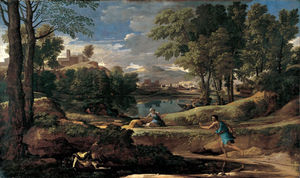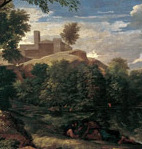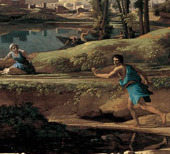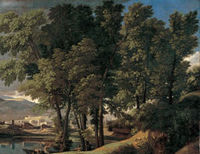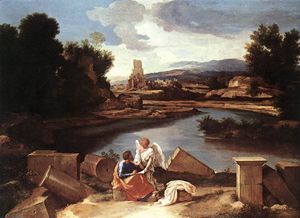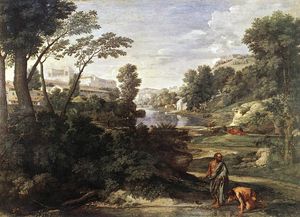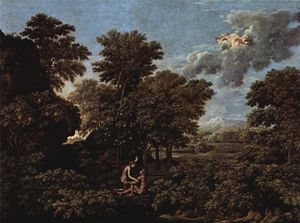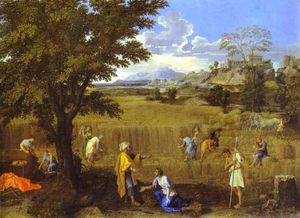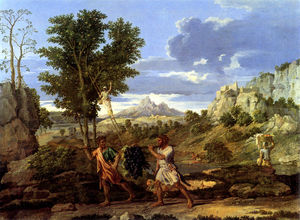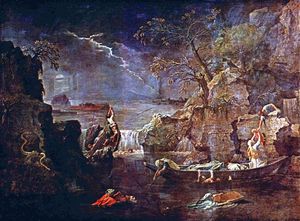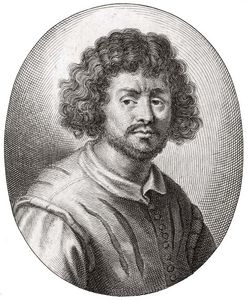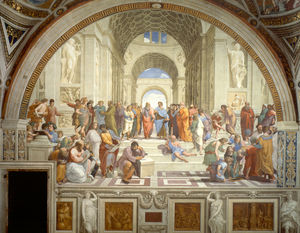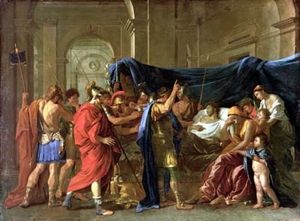Landscape with a Man Killed by a Snake
- Date of Creation:
- 1648
- Alternative Names:
- Landscape with Cadmus and the Snake
- Height (cm):
- 118.20
- Length (cm):
- 197.80
- Medium:
- Oil
- Support:
- Canvas
- Subject:
- Landscapes
- Art Movement:
- Baroque
- Created by:
- Current Location:
- London, United Kingdom
- Displayed at:
- National Gallery London
- Owner:
- National Gallery London
- Landscape with a Man Killed by a Snake Page's Content
- Story / Theme
- Analysis
- Critical Reception
- Related Paintings
- Artist
- Art Period
- Bibliography
Landscape with a Man Killed by a Snake Story / Theme
If the viewer doesn't look at Poussin's Landscape with a Man Killed by a Snake too closely, he may just think that it's yet another simple and idyllic pastoral scene. Anything more than a cursory glance, however, reveals the chilling opposite: this is not a painting about the heroic perfection of nature, but about death, terror and dread.
In the immediate foreground, a giant snake smothers a pale green corpse; screaming in fright, a man flees the scene, his shouts causing alarm to a washerwoman in the distance. The figures are miniscule in comparison to the landscape that dominates the picture, but their gestures and expressions are so evocative and make a lasting impression on the viewer.
Art historians have long debated the possible meaning of Landscape with a Man Killed by a Snake (see different interpretations below), but have more or less agreed that this subject has no literary source. Some attempts have been made to identify the location of the painting as the area around the town of Fondi, situated south-east of Rome, whose population was devastated by a terrible plague of invading snakes from the nearby swamplands during the 17th century.
The Commission:
Poussin's painting was completed on August 31, 1648 for the French banker and silk merchant Jean Pointel, who was originally from Lyon but based in Paris. Pointel could have come to know Poussin during one of his many business trips to Rome.
Pointel was one of Poussin's major patrons and owned several of his paintings, commissioning or buying 15 paintings over the course of 11 years, including The Judgment of Solomon and Rebecca and Eliezer. Not much is known about Pointel, but he and Poussin seem to have been quite close.
Famous art historian Anthony Blunt suggests that the two may have been in Naples together around 1647. During this trip they would have passed through Fondi, and seeing the devastation of the snake infestation could have been the inspiration for this picture.
Landscape with a Man Killed by a Snake Analysis
Painted towards the end of his career, Landscape with a Man Killed by a Snake is an excellent example of Poussin's mature style. The work evidences an unprecedented brilliance in the complexity of the composition and coloring, and is particularly notable for the following qualities;
Composition:
Poussin wasn't an artist to neglect detail and the composition of this painting is perfectly planned. The work has been described as a "study of fear": the horror of the terrible scene in the foreground echoes through the rest of the composition. The terrible, putrid corpse and the man-hungry snake constitute the apex of the drama; this horrible scene is seen by the fleeing man, whose terror alarms the washing woman, who has not spotted the snake; meanwhile, the fishermen in the background are still oblivious to the tragedy.
In this sense, it is a painting about seeing and not seeing, of fear communicated by sight and by sound. Poussin emphasizes the different stages of the drama (and helps guide the viewer's eye) by placing each of his figures at a different level of space, and with his use of light and dark.
Color palette:
Poussin always carefully planned his colors to produce a particular psychological or emotional reaction in the viewer. In Landscape with a Man Killed by a Snake, the artist uses a particularly strident shade of green in his flesh tones to produce a shocking, unpleasant effect.
From the rotting green corpse and the greenish cast to the fleeing man's face and the sickly pallor of the washer woman, Poussin's palette is designed to disturb.
Heroic landscape:
Landscape with a Man Killed by a Landscape is an excellent example of the painter's enormous talent at rendering idyllic landscapes in a "heroic" style. This beautiful landscape adds to the tension in the painting by creating a contrast with the horrific ugliness of the snake, the corpse, and the green pallor of the other figures; Poussin often uses this technique of contrasting beauty with pain throughout his oeuvre.
One influential art historian, Louis Marin, has described this perfect landscape as a kind of "backdrop" against which the dramatic action of the narrative is set, as if this painting were a theatre stage.
Landscape with a Man Killed by a Snake Critical Reception
As always with Poussin's paintings, there is no one easy explanation for Landscape with a Man Killed by a Snake. Poussin's intention may have been perfectly simple when he executed this painting, or perhaps he intended for the image to be obscure and have multiple layers of meaning; regardless, art historians just can't agree on what this painting means.
For years, it was thought that Poussin's landscape was based on the legend of Cadmus and the dragon, and in fact was known as Landscape with Cadmus and the Snake. According to the Ovidian myth, a man named Cadmus received a mission from the god Apollo to go and found the city of Thebes. Upon arriving at a likely spot for his new city, Cadmus sent some of his men down to the river to get some water, where they were all devoured by a dragon which lived in the river's depths.
This interpretation has since been discarded, because the dreadful beast in Poussin's painting is clearly a snake, not a dragon, and furthermore depictions of the myth of Cadmus tend to be very different from this image, showing the masses of corpses the dragon has destroyed.
Nonetheless, some believe that this story was at least an inspiration for the painting, particularly in light of at least one depiction of the myth of Cadmus which bears some compositional resemblances to the French Baroque artist's picture.
The eminently respected contemporary art historian T. J. Clarke has fancifully hypothesized that Poussin's Landscape with a Man Killed by a Snake is biblical in subject. Clarke chose not to base his interpretation on traditional art historical methodologies, but instead just looking at the picture and interpreting what the image evoked.
For Clarke, the painting suggested the story of the fall of man: the deadly snake is the diabolic snake who forces Adam and Eve out of the garden, thus introducing them to a world of death, peril and hard labor. Clarke's interpretation may not be grounded in fact, but it is not entirely implausible as a theory, either.
Another art historian named Sheila Barker has put forth a very convincing argument which holds that Poussin's landscape was inspired by the fear of plague that was sweeping through Italy in the mid-17th century. In 1630, Italy was hit with the worst outbreak of bubonic plague of the entire century, and panic ran high even in Rome, which was relatively protected from the illness.
The bustling metropolis lost a large percentage of its population who fled to the isolated, sparsely countryside in a panic, hoping to avoid the deadly contagion.
Ever since it was believed that snakes and other swamp creatures were the source of plague, and could spread the contagion with their very breath. It was also believed that a state of fear or depression could bring on the plague. In this scenario, Poussin's painting would deal with both threats: both the deadly snake and the hysterical fear of the fleeing man and the washer woman could spread the terrible plague.
The landscape is thus a picture about the fear, dread and terror sweeping the nation, and could perhaps be intended as a kind of cathartic experience for the 17th century viewer.
Landscape with a Man Killed by a Snake Related Paintings
Landscape with a Man Killed by a Snake Artist
Poussin was traumatized by his wretched experience painting for King Louis XIII at the Louvre in the late 1630s, and after returning to Rome in 1642, decided to paint only the subjects he wanted, in the style he wanted, regardless of his patron. Poussin's most important paintings from this period are his landscapes: the artist had always loved to sketch landscapes in the Roman countryside with fellow Frenchman Claude Lorrain, and around 1648, the painter began to concentrate on them almost exclusively.
In these paintings the human figure shrinks, nature takes over the picture plane, and space opens up, receding almost to infinity. Like the landscapes painted by Italian Baroque artist Annibale Carracci, Poussin's landscapes are painted in an idealized, "heroic" style: he paints the world not as it is, but as it should be.
Many art historians interpret Poussin's landscape pictures as illustrative of his belief in the ancient Greek philosophy of Stoicism, which holds than man must be strong, virtuous, and lead an ascetic life in order to overcome destructive forces.
In Poussin's mature period, Greco-Roman friezes, antique statues, and ancient philosophy were his most important influences. Masters of the Italian Renaissance were also an important influence, especially Raphael and Leonardo da Vinci.
Poussin was neither the symbol of 17th century French painting and painter of the establishment, nor was he completely devoid of Baroque dynamism and emotion. Poussin himself would hardly have cared whether or not he was adored or reviled, however. This artist, a fervent believer in Stoicism, appears to have been interested in little more than his studies and his painting; fame and wealth were but mere secondary concerns.
Poussin's sober personality and his carefully thought out theories of art have earned him the nickname of "the philosopher painter."
Landscape with a Man Killed by a Snake Art Period
Technically, Poussin is one of the major painters of the French Baroque. In reality, however, the artist spent almost his entire career living and working in Rome, and could thus be considered as much an Italian painter as a French painter (similar to the case of Spanish Baroque artist Jusepe Ribera). Poussin may have lived in a different country, however, but the impact of his art back home cannot be overestimated.
Poussin's style became the official style at the French Academy in Paris for the rest of the 17th century, and Poussin's paintings were much admired by France's top historical figures, like King Louis XIII, Cardinal Richelieu, King Louis XIV, and his ministers Colbert and Le Brun. Thus, even if Poussin wasn't living and working in the heart of the French Baroque, he did have a profound influence on the molding of its style and concerns.
Furthermore, although he lived in Rome for most of his adult life, Poussin was not immune to current events in his motherland: Poussin's correspondence reveals that the civil war of the mid 1640s was extremely upsetting for the artist.
Poussin's paintings may not have been known to a wide audience during his own lifetime, as the artist painted almost exclusively for elite, private patrons, but his art and theory of painting enjoyed undeniable popularity and had an enormous influence on art criticism of the age.
Yet, with the arrival of Romanticism things began to change. Not only was Poussin's art derided by new generations of up-and-coming artists, but art critics began to turn against it as well. The very end of the century started to see a turn in opinion as avant-garde Post-Impressionist painter Paul Cézanne was unequivocally a fan of Poussin and greatly inspired the modern artist in many of his abstract compositions.
Poussin's reputation began to be restored in the 20th century. Anthony Blunt, that notorious Soviet spy-cum-art historian, is widely regarded as the preeminent Poussin expert of the century, and is the author of the definitive tomes on the artist. Poussin still may not be terribly popular amongst museum goers, but the artist has assuredly earned his place as one of the greatest masters in Western art.
Landscape with a Man Killed by a Snake Bibliography
For more information about Poussin and his works please refer to the recommended reading list below.
• Bätschmann, Oskar. Nicolas Poussin: Dialectics of Painting. Reaktion Books, 1990
• Beresford, Richard. A Dance to the Music of Time by Nicolas Poussin. Trustees of the Wallace Collection, 1995
• Blunt, Anthony. The Paintings of Nicolas Poussin: Critical Catalogue. Phaidon, 1966
• Carrier, David. Poussin's Paintings: A Study in Art-Historical Methodology. Pennsylvania State University Press, 1993
• Cropper, Elizabeth and Charles Dempsey. Nicolas Poussin: Friendship and the Love of Painting. Princeton University Press, 1996
• Friedlaender, Walter. Nicolas Poussin, a New Approach. Abrams, 1966
• Lagerlöf, Margaretha Rossholm. Ideal Landscape: Annibale Carracci, Nicolas Poussin, and Claude Lorrain. Yale University Press, 1990
• McTighe, Sheila. Nicolas Poussin's Landscape Allegories. Cambridge University Press, 1996
• Oberhuber, Konrad. Poussin, the Early Years in Rome: the Origins of French Classicism. Hudson Hills Press, 1988
• Olson, Todd. Poussin and France: Painting, Humanism, and the Politics of Style. Yale University Press, 2002

